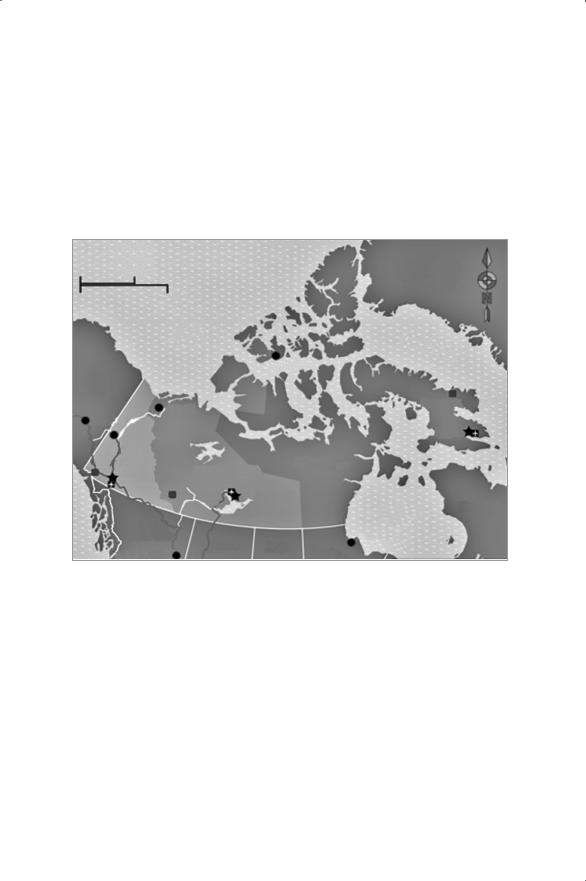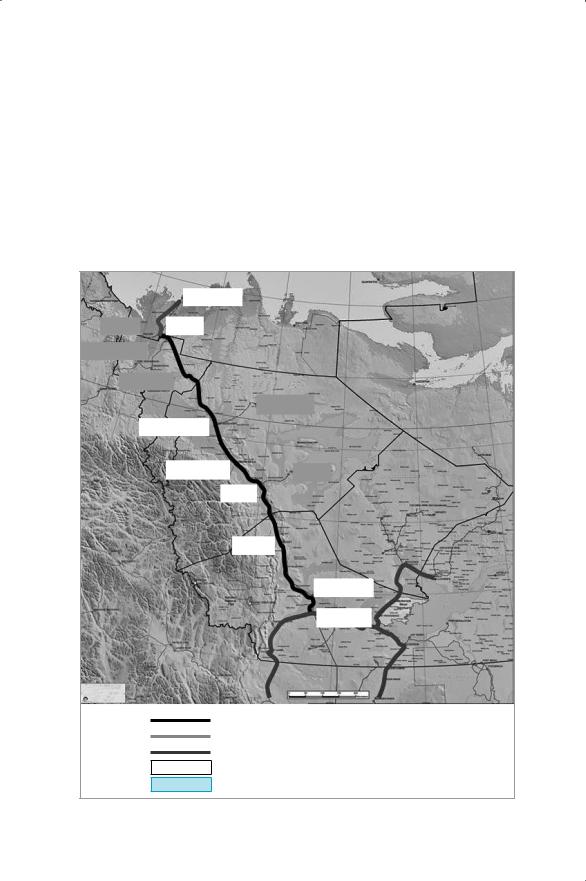
NPAC 2014 Proceedings_final
.pdf

PART IV
INNOVATIONS APPLICABLE TO THE ARCTIC
285

286 |
Innovations Applicable to the Arctic |

11.A Fibre Optic System for Canada’s Western Arctic
Michael Aumond
This article describes the rationale, design, and implementation strategy for a high-speed fibre optic system connecting Canada’s Western Arctic to the Southern Canada fibre optic telecommunication grid. The article describes the Mackenzie Valley Fibre Link (MVFL) project and addresses:
1.The project objectives, focusing on the Government of the Northwest Territories (GNWT) public good objectives of providing highspeed delivery of social services programing, health care, education and outreach services and of providing a high-speed fibre-optic telecommunications “enabling” infrastructure to support economic diversification for the region by connecting relatively small rural and remote communities to the national and international marketplace.
2.The economic and technological challenges of providing fibre-optic communications in Canada’s North, and the decision by the GNWT to strategically invest in a long haul backbone system, providing telecommunications transport facilities from northern communities to an existing southern location on Canada’s existing fibre grid.
3.The private public partnership (PPP) chosen for the execution and long-term operation of the system, and the risk profile assumed both by the private sector partner and by the government.
4.The requirement for a robust business model for the government’s investment in the MVFL, and the benefit of an existing satellite receiving station in supporting both the long term revenue base of the MVFL and the government’s economic diversification objectives in the region.
PROJECT LOCATION AND OBJECTIVES
Canada’s Northwest Territories (NWT) extends from the northern boundary of Alberta to Canada’s high Western Arctic. The NWT is approximately 500,000 sq miles, and has a population of 43,000 located in
287

288 |
Innovations Applicable to the Arctic |
33 communities. The largest community is Yellowknife, with a population of approximately 20,000. The southern Canada fibre optic grid extends to Yellowknife and communities in southern NWT. Northern communities are served either by satellite or by terrestrial microwave communications systems. Both of these technologies result in higher prices, limited capacity, and in some cases, slower connection speeds.
500 km |
|
|
500 Miles |
|
Arctic |
|
Ocean |
Alaska |
Resolute |
|
|
(USA) |
|
Fairbanks |
lnuvik |
|
GREENLAND (Denmark)
Davis |
Strait |
|
Auyuittuq NP
Dawson City |
|
|
|
|
lqaluit |
Yukon |
|
|
|
|
|
Kluane NP |
Northwest |
|
Nunavut |
|
|
Whitehorse |
|
|
|
||
Territories |
|
|
|
|
|
Nahanni NP |
Yellowknife |
|
|
Quebec |
|
|
|
Hudson |
|||
|
|
|
|
|
|
British |
|
|
|
Bay |
|
Columbia |
Alberta |
Sask. |
|
Churchill |
|
Fort St. John |
Manitoba |
|
|||
|
|
|
|
||
Figure IV-1. Canada’s Northwest Territories
The difference in telecommunications technologies used to provide telecommunications service to our northern communities translates into a disparity in services that can be delivered to our communities. Modern government services, including health care, education, social outreach programs, and government administrative services rely on the ability to deliver these services in an efficient and cost-effective manner. They often use high-speed Internet services as a key transport element of the services delivery component. Without access to high-speed and affordable Internet services, communities may not have access to needed, modern government services. Additionally, in an increasing competitive global economy, the ability to attract high-quality investments in the north, leading to jobs and

A Fibre Optic System for Canada’s Western Arctic |
289 |
value-added services, is often contingent on access to modern, high-speed, reliable communications systems.
The GNWT has, as two key priorities in this area:
a)Improved delivery of GNWT public services to northern communities
b)Creating an environment to attract economic activity in the NWT and regional economic diversification.
|
|
|
|
|
|
|
Tuktoyaktuk |
|
|
|
|
|
|
|
|||||
|
|
|
|
|
|
|
|
|
|
|
|
|
|
|
|
|
|
|
|
|
|
|
|
|
|
|
|
|
|
|
|
|
|
|
|
|
|
|
|
|
Aklavik |
|
|
|
Inuvik |
|
|
|
|
|
|
|
|
|
|
|
|
||
|
|
|
|
|
|
|
|
|
|
|
|
|
|
|
|
|
|
|
|
|
|
|
|
|
|
|
|
|
|
|
|
|
|
|
|
|
|
|
|
Fort McPherson |
|
|
|
|
|
NORTHWEST |
|
||||||||||||
|
|
|
|
|
|
|
|
|
|
||||||||||
|
|
|
|
|
|
|
|
|
|
|
TERRITORIES |
|
|||||||
|
|
Tsiigehtchic |
|
|
|
|
|
|
|||||||||||
|
|
|
|
|
|
|
|
|
|
|
|
|
|
|
|
|
|||
|
|
|
|
|
|
|
|
|
|
|
|
|
|
|
|
|
|
|
|
|
|
|
|
|
|
|
|
|
|
|
|
|
|
Colville Lake |
|
|
|
||
|
|
|
|
|
|
|
|
|
|
|
|
|
|
|
|
|
|
||
|
|
|
|
|
|
|
|
|
|
|
|
|
|
|
|
|
|
|
|
|
|
|
Fort Good Hope |
|
|
|
|
|
|
|
|
|
|
|
|||||
|
|
|
|
|
|
|
|
|
|
|
|
|
|
|
|
|
|
||
|
|
|
|
|
|
|
|
|
|
|
|
|
|
|
|
|
|||
|
|
|
|
|
|
Norman Wells |
|
|
|
|
|
Deline |
|
|
|||||
|
|
|
|
|
|
|
|
|
|
|
|
|
|
|
|
|
|
||
|
|
|
|
|
|
|
|
|
|
|
|
|
|
|
|
|
|
|
|
|
|
|
|
|
|
|
|
|
|
|
|
|
|
|
|
|
|
|
|
|
|
|
|
|
|
|
|
|
|
|
Tulita |
|
|
|
|
|
|
||
|
|
|
|
|
|
|
|
|
|
|
|
|
|
|
|
|
|
|
|
|
|
|
|
|
|
|
|
|
|
|
|
|
|
|
|
|
|
|
|
|
|
|
|
|
|
|
|
|
|
|
|
Wrigley |
|
|
|
|
|
||
|
|
|
|
|
|
|
|
|
|
|
|
|
|
|
|
|
|
|
|
|
|
|
|
|
|
|
|
|
|
|
|
|
|
|
|
|
|
|
|
|
|
|
|
|
|
|
|
|
|
|
|
|
|
|
|
|
Fort Simpson |
|
|
|
|
|
|
|
|
|
|
|
|
|
|
|
|
|
|
|
|
|
|
|
|
|
|
|
|
|
|
|
|
|
|
|
|
|
|
|
|
|
|
|
|
|
|
|
|
|
|
|
|
|
|
|
|
|
|
|
McGill Lake |
|
|
|
|
|
|
|
|
|
|
|
|
|
|
|
|
|
|
|
|
|
|
Fort Simpson
Deline
Mackenzie Valley Fibre Route (McGill Lake to Inuvik)
Extension to Tuktoyaktuk
Existing Fibre Optic Links
Communities to be served directly by MVFL
Communities that could be connected to the MVFL by microwave radio links
Figure IV-2. MVFL route

290 |
Innovations Applicable to the Arctic |
The purpose of the Mackenzie Valley Fibre Link Project is to realize both of these priorities in the Mackenzie Valley region of NWT and to improve overall connectivity. The system extends from the southern Canada fibre grid at McGill Lake in southern NWT to Tuktoyaktuk on the shores of the Beaufort Sea. Six communities will be served directly on the fibre route, and an additional four communities could be served in the future by short microwave connecting systems from communities located close to the MVFL, but not directly on the fibre route. Inuvik is the largest community, with a population of 3,500, and the region has a total population of 10,100. The distance from McGill Lake to Tuktoyaktuk is approximately 1,200 km.
ECONOMICS OF NORTHERN TELECOMMUNICATIONS SYSTEMS
Telecommunications systems can be classified broadly into three major components, as shown in the diagram below:
In the north, distances between communities are typically much larger
Local
Central
Long distance
Local |
Switching |
Back Haul Transport |
distribution |
centre |
Telecommunication |
Figure IV-3. Three major components of telecommunications systems

A Fibre Optic System for Canada’s Western Arctic |
291 |
than in southern Canada, and the communities themselves are much smaller. Conversely, the communities in the north tend to be more compact than in rural areas in the south or in peri-urban areas. These differences have a profound effect on the economics of providing modern, high-speed telecommunications services to northern communities at an affordable cost.
In typical southern Canadian networks, the cost of providing local loop services in rural areas is the dominant cost. In general, the cost of the backhaul system is a relatively minor component on a per-customer basis.
In northern networks, the situation is reversed. The cost of the backhaul networks is almost always the single most significant cost component. The provision of local service to northern customers in the relatively compact communities is not, by comparison, a large cost component. Technology is providing alternative ways of providing relatively inexpensive local loop alternatives (for example, wide bandwidth cellular distribution systems). Additionally, the cost of switching systems, including ancillary elements such as building space and power consumption, has fallen significantly.
In economic terms, the high cost of backhaul systems in the north means that telecommunication service providers have little choice but to charge significantly higher prices to serve these communities. This has the effect of generating a systemic disadvantage to northern communities both in terms of the effective and efficient provision of public good services to local residents and in attracting firms to provide jobs and economic opportunities for northern communities.
Government of Northwest Territories (GNWT) Investment Strategy for the Mackenzie Valley Fibre Link
The GNWT developed an investment strategy specifically to address the high-cost backhaul segment of northern telecommunications systems. The government has no interest in operating a broader telecommunications service, or in becoming a telecommunications service provider, other than the facilitation of important government services to residents and businesses. For those areas where the telecommunications market functions well, the government has no interest in intervening.
The GNWT strategy has two basic components:
a)Limiting investment to the backhaul portion of the network from Tuktoyaktuk to McGill Lake, which is the closest point in the

292 |
Innovations Applicable to the Arctic |
southern Northwest Territories that has an existing high-speed fibre system.
b)Establishing a PPP business arrangement to design, build, finance, operate and maintain the MVFL system. The term of the contract is for a period of 20 years from the service commencement date.
Technology Challenges of the Mackenzie Valley Fibre Link (MVFL)
The route of the MVFL, extending from McGill Lake in the south to Tuktoyaktuk in the north, is characterised by a rapid change in environmental conditions. From the sporadic permafrost in the subarctic region in the south, to continuous permafrost in the polar north, the MVFL has been designed to meet the challenges of operating in a hostile, and changing, northern and Arctic environment. Specific challenges unique to the MVFL environment are:
Climatic and environmental conditions and route geography
The southern end of the MVFL at McGill Lake is located in a subarctic climatic region, and the route extends to a polar climatic region at Tuktoyaktuk in the north. The route is divided into four sections:
1)An all-weather gravel road section from McGill Lake for approximately 320 km to Wrigley.
2)A winter road section from Wrigley for approximately 475 km to Fort Good Hope, close to the Arctic Circle,
3)A section from Fort Good
Hope to Inuvik (a distance of approximately 360 km),
along the proposed route of an extension of the NWT’s Mackenzie Valley Highway. This is the most challenging section of the route and requires the use of mobile crew camps.
4)The final section from Inuvik to Tuktoyaktuk, following the allweather Dempster Highway that is currently under construction.

A Fibre Optic System for Canada’s Western Arctic |
293 |
Permafrost
Permafrost along the MVFL route ranges from sporadic, to discontinuous, to extensive discontinuous. Permafrost consists of three layers: an active layer, which is subject to a freeze-thaw cycle every year, a permanently frozen layer, and a transition layer, which resides between the active layer and the permanently frozen layer, and can contain “bubbles” of water and/ or ice and an area called an ice lens when frozen. When this layer melts, the ground above sometimes gives way in a process called “slumping.”
Permafrost is a problem because, in summer, the active layer of the permafrost becomes similar to a wet land swamp and is unable to support the weight of installation equipment. Winter is the only season when installation can occur, and contractors have to wait until the ground is frozen to the point that transport and installation equipment can be safely moved.
Permafrost has three important impacts on the MVFL installation and operation.
Permafrost:
a)Limits the installation for the northern two-thirds of the MVFL to the winter season, lasting typically from early January to early April.
b)Affects the installation techniques to be employed
a n d t h e f i b r e o p t i c cable. The MVFL uses a marine-type cable for the northern two-thirds of the route because of its superior characteristics
For these sections of the route, the cable is installed directly in a trench, in the active layer of the permafrost
tensile and crush-resistant strength
C)Limits the options for cable replacement in the event of a cable break. For parts of the year when the route is inaccessible, repairs will be completed using a temporary cable which will be laid directly on the ground. As soon as conditions permit, a permanent repair cable will be installed underground.
